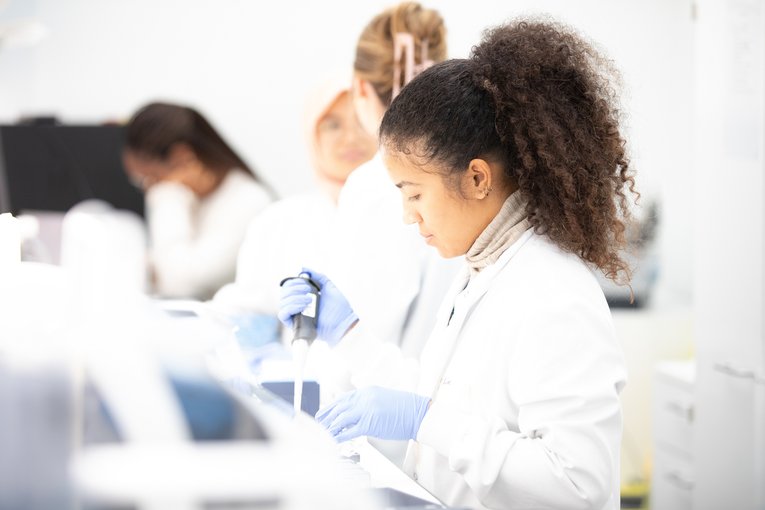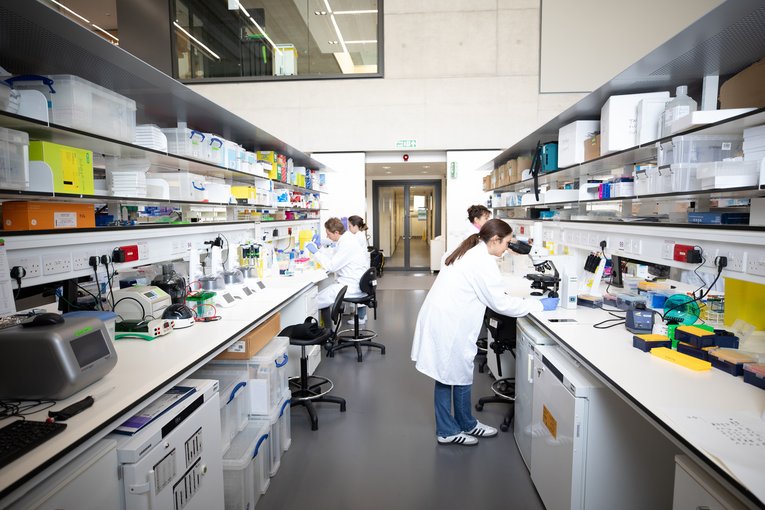
https://www.gosh.nhs.uk/news/uninherited-mutations-cause-spina-bifida/
Uninherited mutations cause spina bifida
19 Feb 2021, 4:53 p.m.
Scientists at the UCL GOS Institute of Child Health reveal that new genetic mutations which occur during embryonic development can cause the severe birth defect spina bifida. Many genes have been implicated in spina bifida, and mutations which are not inherited from either parent had been documented in people with this condition. These uninheritable mutations may only affect a small subset of cells, distributed mosaically within tissues, so it was not known whether they could cause spina bifida. The new research, published in the journal Nature Communications, demonstrates that mutating one gene in just 16% of developing spinal cord cells of mouse embryos is sufficient to cause spina bifida.
Spina bifida is one of a group of birth defects called neural tube defects. Some neural tube defects can be prevented by taking folic acid supplements before and during early pregnancy, yet these conditions continue to affect around one in every thousand pregnancies globally. People born with this condition suffer nerve damage because part of their spinal cord remains exposed while in the womb. Advances in recent years now allow surgeons in a few centres around the world, including locally at GOSH and UCLH, to perform surgery on foetuses in the womb to reduce the neurological consequences of their condition. Some environmental factors are known to increase the risk of these conditions occurring, but very few affected individuals or their parents receive a meaningful genetic diagnosis. The discovery that mosaic mutations which cause spina bifida may not be inherited from either parent, and are not necessarily present in blood or saliva commonly used for genetic testing, may explain why.
Genetic mutations happen in every cell throughout development. In order to grow from a fertilised egg cell into a foetus, each of our cells must replicate and divide in order to increase in number and grow. Cells must copy their DNA every time they divide, but mistakes can happen which change the DNA sequence in the daughter cells. These DNA code mistakes, called mutations, are then inherited by all cells derived from that cell. If these mutations happen in germ cells – the egg and sperm cells – they are inherited from parent to offspring. Many mutations do not happen in germ cells, but rather in cells which give rise to specific tissue types. This property was used in the recent study, together with the ability to induce mutation in a small proportion of cells which form the developing spinal cord of mice. The researchers then counted the proportion of spinal cells which harboured this mutation in foetuses which successfully covered their spinal cord with skin, versus those which got spina bifida. The result showed that this process is surprisingly vulnerable to these uninheritable, mosaic mutations.

Failed and successful closure of mouse spinal cord
The specific mutation studied caused inactivation of a single gene called Vangl2. This gene is part of a cellular signalling pathway which conveys directionality, known as the planar cell polarity pathway. Mutations in this pathway had been identified in people who have neural tube defects, and recent reports from the USA and China previously found mosaic planar cell polarity mutations in 15% of human foetuses with spina bifida. This cellular signalling pathway requires cells to interact with their neighbours in order to communicate directional information. This property underlies vulnerability to mosaic mutations because each mutant cell stops each of its neighbouring cell from functioning to promote spinal cord development. Each cell has six neighbouring cells on average, massively amplifying the effects of each mutant cell. Dr Gabriel Galea, principal investigator and lead author on the study explains, “We found that the requirement for cells to talk to each other makes them exquisitely vulnerable to mutations in the planar cell polarity pathway. We now need to understand whether this vulnerability extends to other genes which could cause spina bifida. Detecting these mosaic mutations in living people will require technological advances and careful analysis of tissues resected during surgery.”
This research was published in Nature Communications.

Dr Galea’s research is supported by a Clinical Research Career Development Fellowship from the Wellcome Trust and research at the Institute of Child Health is supported by NIHR Biomedical Research Centre funding. To learn more about spinal cord development described during a UCL Lunch Hour Lecture, visit www.youtube.com/watch?v=iAf-RHRQCGQ.

When it is OK to link our data?
A guide for researchers by children and young people containing key principles which reflect children’s and young people’s views about when it is ok to link their data for research.

NIHR launches £13.7m investment into brain tumour research
The National Institute for Health and Care Research (NIHR) has announced a £13.7 million investment that will support ground-breaking research to develop novel brain tumour treatments in the UK.

New consortium aims to help improve care for arthritis patients
A new UK-led research group, including Great Ormond Street Hospital and University College London, aims to improve the lives of children, young people and adults with arthritis by defining for the first time what being in ‘remission’ from arthritis truly

Update for patients and families on industrial action - December 2025
As you may be aware, some of our Resident Doctors will be taking part in planned industrial action from 7am on Wednesday 17 December to 7am on Monday 22 December.
